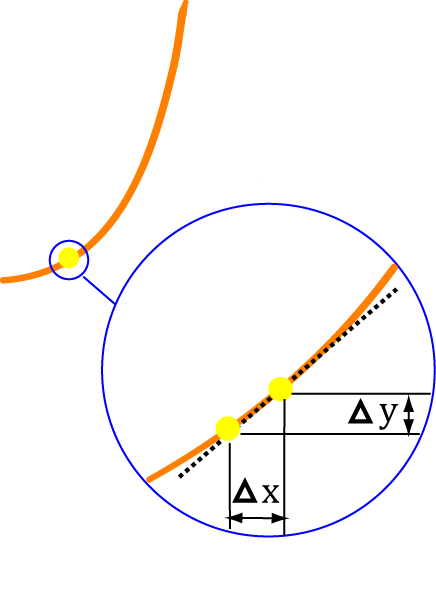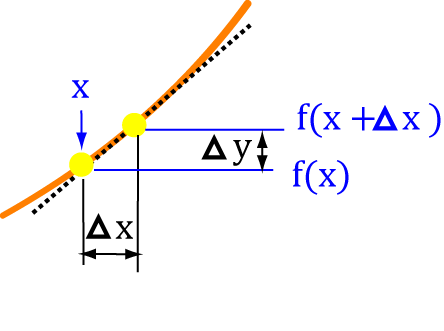Calculus
Chapters
Notation for Derivatives
Notation for Derivatives
Derivatives as Limits
rates of change. As we saw in the introductory article
on derivatives, derivatives tell use all about instantaneous rates of change, and can be found by taking the limit of the average rate of change as the
time interval gets smaller and smaller.

Building up the dy/dx notation
In this article, we're going to explore the notation for derivatives. The introductory article on derivatives looked at how we can calculate derivatives as limits of average rates of change. We're going to use this idea here, but with different notation, so that we can see how Leibniz's notation \(\dfrac{dy}{dx}\) for the derivative is developed.
1. Add \(\Delta x\) and \(\Delta y\) to the picture
When we increase \(x\) by a tiny amount - let's call it \(\Delta x\), \(y\) also increases by a small amount that we'll call \(\Delta y\):2. Find the change in \(y\)
You guessed it, we need to subtract things here! Find the new value of \(y\) minus the old value of \(y\):3. Now turn it into a rate of change
Remember how to find the average speed of an object? Well, here we want to find the average speed of the change in \(y\), so we divide by the length of our interval: \(x + \Delta x - x =\Delta x\).
4. Now make \(\Delta x\) really really small
Does this sound like taking a limit? Of course it is, but we don't want to say that. We let \(\Delta x\) approach zero, but instead of using limit notation, we write it as \(dx\):

Test it Out on a Function
Let's try our brand new formula out on the function \(f(x) = x\)
We know the derivative of \(f(x) = x\) is \(f'(x) = 1\), so it looks like it works! Maybe that one was just a bit too easy, though. Let's try another: \(f(x)= x^2\)
We know that the derivative of \(f(x) = x^2\) is \(f'(x) = 2x\), so it worked again!
In practice, we really don't need to go to all this bother to find the derivative of a function, but it's nice to know we can! Usually, we just use the rules of derivatives.
Description
Calculus is the branch of mathematics that deals with the finding and properties of derivatives and integrals of functions, by methods originally based on the summation of infinitesimal differences. The two main types are differential calculus and integral calculus.
Environment
It is considered a good practice to take notes and revise what you learnt and practice it.
Audience
Grade 9+ Students
Learning Objectives
Familiarize yourself with Calculus topics such as Limits, Functions, Differentiability etc
Author: Subject Coach
Added on: 23rd Nov 2017
You must be logged in as Student to ask a Question.
None just yet!